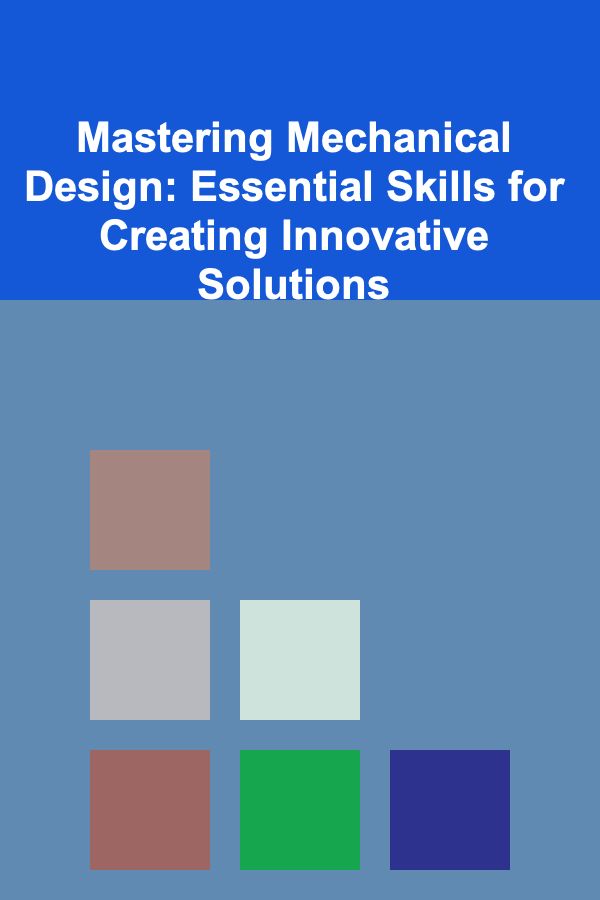
Mastering Mechanical Design: Essential Skills for Creating Innovative Solutions
ebook include PDF & Audio bundle (Micro Guide)
$12.99$9.99
Limited Time Offer! Order within the next:

Mechanical design is a crucial field that drives the development of products, machines, and systems across various industries, from automotive to aerospace, from medical devices to consumer electronics. A skilled mechanical designer must master a wide range of technical competencies and soft skills to create innovative and effective solutions that meet both functional requirements and manufacturing constraints.
This guide delves into the essential skills every mechanical designer should master to thrive in the modern design landscape. From understanding core engineering principles to harnessing cutting-edge software tools and fostering a mindset of creativity and problem-solving, this article aims to provide a comprehensive roadmap for mastering mechanical design.
Developing a Solid Foundation in Engineering Principles
Before diving into the technical aspects of design software and tools, a deep understanding of engineering principles is paramount. These principles form the foundation on which all mechanical designs rest. A well-rounded knowledge of the following areas is essential for a successful mechanical designer:
Mechanics of Materials
Mechanical design starts with the ability to understand and apply the mechanics of materials. This includes knowing how materials respond to forces, deformations, and stresses. The following are key concepts to understand:
- Stress and Strain: Mechanical designers must grasp how materials respond to internal forces (stress) and how they deform (strain) when subjected to those forces. This helps in selecting materials that will withstand operational loads without failure.
- Tensile, Compressive, and Shear Strength: Understanding these material properties allows you to choose the right material based on its ability to withstand different forces, such as stretching, compressing, or shearing.
- Fatigue and Durability: Designers must anticipate long-term material performance, especially when the part will undergo repetitive loading cycles.
Thermodynamics and Heat Transfer
Mechanical systems often need to manage heat, either by dissipating it or utilizing it for efficient operation. A solid understanding of thermodynamics and heat transfer allows mechanical designers to:
- Select materials based on thermal properties (e.g., heat conductivity, thermal expansion).
- Design for temperature control in systems like engines or electronics.
- Optimize heat dissipation in heat exchangers or cooling systems.
Kinematics and Dynamics
Mechanical systems involve movement---whether it's the motion of parts in an assembly or the dynamic interaction between components. Understanding kinematics (the study of motion) and dynamics (the study of forces and their effects) is essential:
- Motion Analysis: Designers need to predict and analyze the motion of moving parts in an assembly to ensure they function as intended without interference or excessive wear.
- Force Distribution: Calculating how forces are transmitted through a system and how they affect each component is key to designing durable and efficient systems.
Material Science
Material science involves understanding the properties of materials at a microscopic level. A mechanical designer must understand how different materials behave under different conditions to make informed choices for design. Key areas include:
- Metals: Steel, aluminum, and alloys, each with specific benefits like strength, weight, and machinability.
- Polymers: Used in applications where flexibility, low cost, or insulation is required.
- Composites: Materials that combine the benefits of two or more materials to provide unique characteristics like high strength-to-weight ratios.
Understanding the interactions between materials and their structural performance is crucial for ensuring that the final design performs as expected.
Mastering CAD Software and Design Tools
With a strong grasp of engineering principles, mechanical designers need to master the software tools that bring their designs to life. Computer-Aided Design (CAD) has become the cornerstone of mechanical design, enabling designers to create precise digital models of parts and assemblies, run simulations, and generate technical drawings for manufacturing.
Key CAD Skills
Mastering CAD software is indispensable for mechanical designers. While different software options are available, the core competencies remain the same. Here are the critical skills required to excel in CAD:
3D Modeling
Mechanical designers must be proficient in 3D modeling to create accurate representations of parts and assemblies. Solid modeling tools enable designers to generate complex geometries and accurately simulate how parts will fit together.
- Parametric Modeling: Understanding the use of parameters (such as dimensions or features) that define the design and enable easy updates and modifications.
- Surface Modeling: This is essential for creating smooth and complex shapes, often required in automotive or aerospace industries.
- Assembly Design: Learning how to correctly assemble multiple parts into a complete system while considering tolerances, interference, and motion.
Simulation and Analysis
Modern CAD tools provide robust simulation capabilities, which enable designers to test their designs virtually before producing physical prototypes. Key types of simulations include:
- Finite Element Analysis (FEA): This technique divides a part into small elements to predict how it will respond to forces, temperatures, or vibrations. FEA helps identify weak points in the design that may need reinforcement or material changes.
- Computational Fluid Dynamics (CFD): Used to simulate fluid flow and heat transfer, CFD is vital for designs involving air or liquid flow, such as pumps, engines, and HVAC systems.
- Motion Analysis: By simulating the movement of parts within an assembly, designers can check for interference, excessive wear, or misalignment before manufacturing the parts.
Generating Technical Drawings
Although 3D models are the heart of modern mechanical design, technical drawings remain a vital aspect of communication in engineering. A mechanical designer must be able to create clear and precise technical drawings that include:
- Dimensions and Tolerances: Detailed specifications of part sizes and allowable deviations from those sizes.
- Bill of Materials (BOM): A list of all components, materials, and assemblies required for manufacturing.
- Assembly Instructions: If the part is part of a larger system, designers need to provide clear assembly guidance, often in the form of exploded views.
Embracing Design for Manufacturability (DFM)
Designing a part that looks good on paper is not enough---it must be manufacturable. DFM is the practice of designing parts and assemblies in a way that reduces manufacturing complexity and cost while maintaining performance. A designer should always keep the following principles in mind:
- Minimize Part Count: Fewer parts typically mean less assembly time and cost. Design components that can be combined into fewer parts without compromising function.
- Ease of Assembly: Parts should be easy to assemble with minimal tools. Designing parts with features that align or fit together naturally can save time and reduce the risk of errors during assembly.
- Consider Manufacturing Constraints: Different manufacturing processes (e.g., casting, machining, injection molding) have their own limitations. A designer should be familiar with these processes and design accordingly.
Understanding and Implementing Prototyping and Testing
Even the most experienced mechanical designers cannot predict every potential issue a design might encounter in the real world. Prototyping and testing are essential to validate design choices and ensure functionality. Prototypes are created using various methods such as:
- 3D Printing: Rapid prototyping technologies like 3D printing allow designers to quickly create a physical model of their design to evaluate form, fit, and function before mass production.
- Functional Testing: Once a prototype is created, testing it under real-world conditions is crucial to identify any weaknesses or failure points in the design. This may involve stress testing, thermal testing, or durability testing.
- Iterative Design Process: Based on testing feedback, designers should be prepared to make adjustments to the design and iterate on their prototypes. This loop of designing, prototyping, and testing is essential for optimizing the final product.
Fostering Innovation and Creative Problem-Solving
While technical skills are essential, creativity and innovation are what set great mechanical designers apart from good ones. Being able to think outside the box and approach problems from different angles can lead to breakthrough designs.
- Think Cross-Disciplinarily: Innovation often occurs at the intersection of disciplines. A mechanical designer should be open to integrating knowledge from other fields, such as electrical engineering, software design, or user experience.
- Understand User Needs: Successful designs must solve real-world problems. Engaging with clients, users, or stakeholders to understand their needs is a key part of the design process. The more informed you are about the challenges your design seeks to solve, the more innovative and effective your solution will be.
- Prototype and Experiment: Don't be afraid to experiment with unconventional ideas. Prototyping is an excellent way to test new concepts and explore innovative solutions without committing to expensive or risky full-scale production.
Conclusion
Mastering mechanical design requires a blend of solid engineering knowledge, proficiency with design tools, and creativity. To create innovative solutions that stand the test of time, designers must constantly refine their technical expertise, adopt new tools and methodologies, and embrace a problem-solving mindset. By honing these essential skills, mechanical designers can create products that are not only functional but also efficient, sustainable, and groundbreaking. Whether you are designing a single part or an entire system, the ability to combine technical knowledge with innovative thinking is what sets the best designers apart.

How to Create a Stress-Free Cleaning Routine for Busy Lives
Read More
How to Make a Checklist for Researching Neighborhoods
Read More
How to Make Money Online as a Dog Trainer: 10 Actionable Ideas
Read More
How to Provide Constructive Feedback on Student Videos
Read More
How to Use Lighting to Create a Relaxing Home Theater Room
Read More
How to Utilize Technology for Property Management
Read MoreOther Products

How to Create a Stress-Free Cleaning Routine for Busy Lives
Read More
How to Make a Checklist for Researching Neighborhoods
Read More
How to Make Money Online as a Dog Trainer: 10 Actionable Ideas
Read More
How to Provide Constructive Feedback on Student Videos
Read More
How to Use Lighting to Create a Relaxing Home Theater Room
Read More